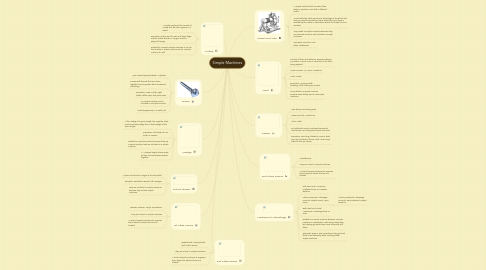Simple Machines
作者:Dustina Hansen


1. 1st Class Levers
1.1. Seesaw, Scissors, Tongs, Screwdriver
1.2. They are a level in simple machines
1.3. A level of simple machines to organize them based on where the force is located
2. 3rd Class Levers
2.1. Baseball Bat, Hockey sticks, Golf Clubs, Broom
2.2. They are a level in simple machines
2.3. A level of simple machines to organize them based on where the force is located
3. Incline Planes
3.1. A plane inclined at an angle to the horizontal
3.2. Example: Switchback Roads, hills, wedges
3.3. They are included in simple machines because they include simple machines
4. Wedge
4.1. A thin wedge of a given length has a greater ideal mechanical advantage than a thick wedge of the same length
4.2. Examples: The blade of a ax, knife, or scissors
4.3. Related to a simple machine because they are a simple machine and are included in a simple machine
4.4. A V-Shaped object whose sides are two inclined planes sloped together
5. Screw
5.1. Is an inclined plane between a cylinder
5.2. Screws with threads that are closer together have a greater ideal mechanical advantage
5.3. Examples: Used in drills, light bulbs, bottle caps, ball point pens
5.4. Is a simple machine and is included in a simple machine
5.5. Metal wrapped up in a metal coil
6. Pulley
6.1. A simple machine that consists of a rope that fits into a groove in a wheel
6.2. Examples: Pulley used to raise and lower flags, make a ladder shorter or longer, used for physical therapy
6.3. Related to a simple machine because it can be found within a simple machine and is a simple machine it's self
7. Work
7.1. Product of force and distance. Requires change in position. Has to move in direction of the force being applied.
7.2. Work Formula: W= Force * Distance
7.3. Units: Joules
7.4. Examples: Moving a desk, throwing a ball, Picking up a book
7.5. They relate to a simple machine because work allows you to use simple machines
8. Power
8.1. How fast you are doing work
8.2. Power Formula: Work/Time
8.3. Units: Watts
8.4. Included with simple machines because of how fast you are using said simple machines
8.5. Examples: How long it takes to move a desk, how long it takes to throw a ball, How long it takes to Pick up a book
9. Mechanical Advantage
9.1. Tells how much a machine multiplies force or increases distance
9.2. Ideal Mechanical Advantage Formula: Output Force/ Input Force
9.2.1. Actual Mechanical Advantage Formula: Input Distance/ Output Distance

